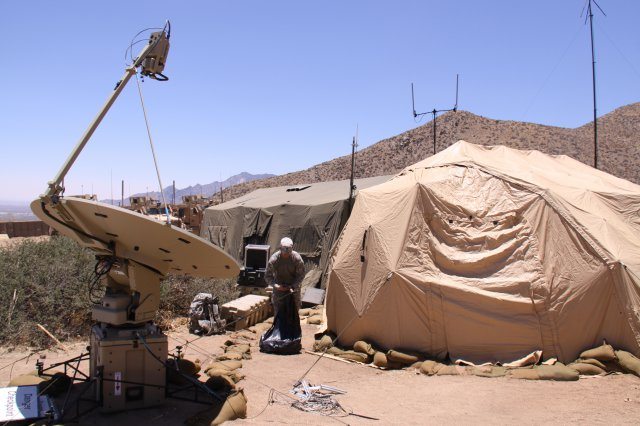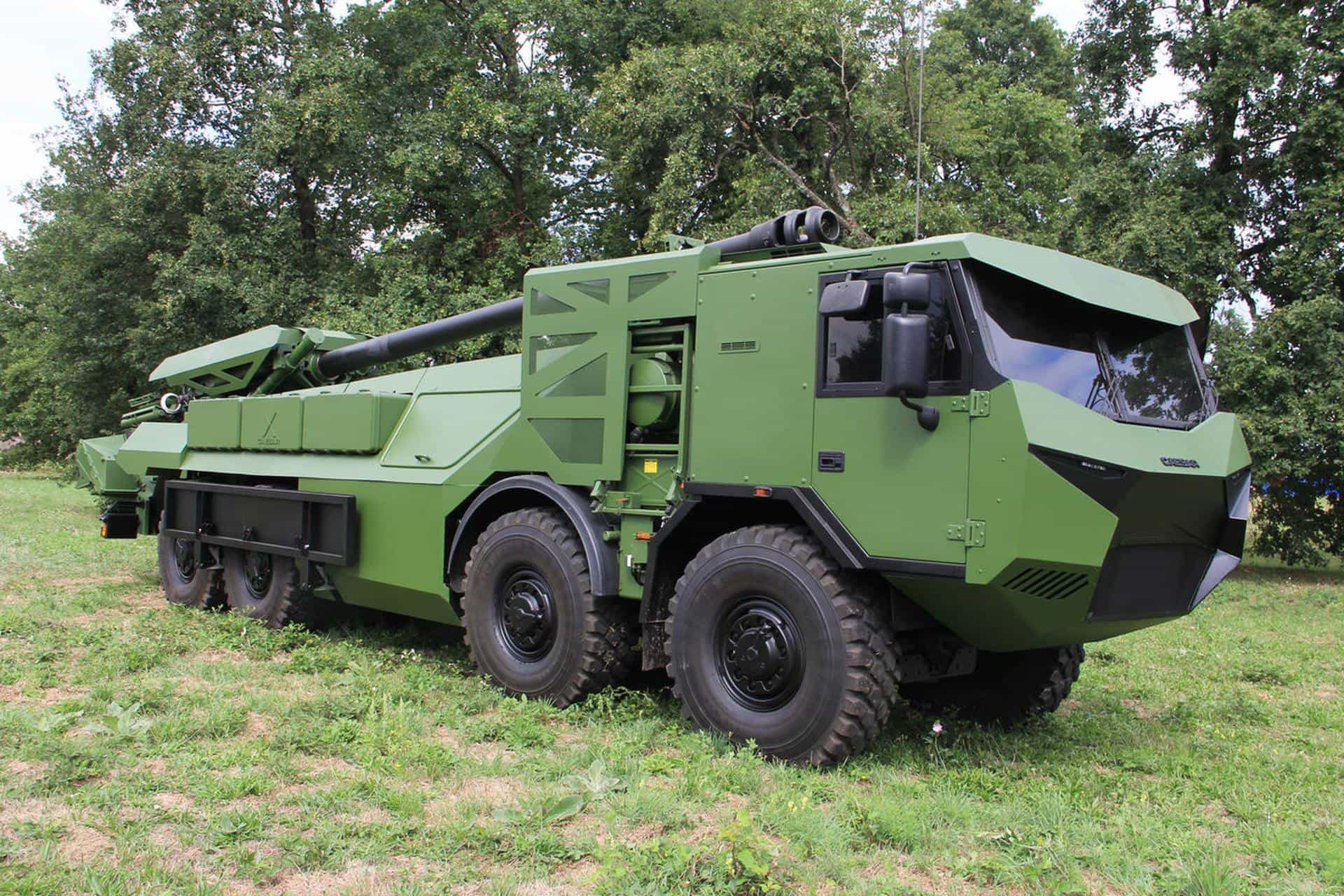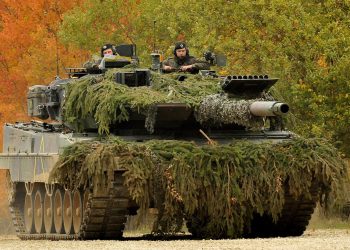When he fought in Iraq in 2007, Capt. Joseph D. Perry did tactical communications “the old school way, with a map board and a radio.”
Today at the Network Integration Evaluation, or NIE, the company commander can take his pick of digital systems to quickly reach both his Soldiers at the tactical edge and his higher headquarters; creating a significant operational advantage.
“It’s a revolutionary thing to push the network all the way down, because it allows a more real-time interchange of information (and) a much more proactive force,” Perry said. “You provide the data up, it’s analyzed, (and) they can turn around and say, ‘Hey, this number matches this number,’ push it right back down to the patrol and say, ‘We need you to go hit this place now.”
Delivering that information dominance at the tactical edge is the driving force behind the NIEs, a series of semi-annual field exercises designed to rapidly integrate and mature the Army’s tactical network. The second event in that series, known as NIE 12.1, officially begins Oct. 31, as Perry and nearly 3,800 fellow Soldiers of the 2nd Brigade, 1st Armored Division evaluate dozens of systems in realistic operational scenarios.
Set in mountainous desert terrain that mirrors the communications challenges of Afghanistan, the three-week event includes one required program of record test for the Joint Tactical Radio Systems, or JTRS, Rifleman Radio. The radio is carried by platoon, squad and team-level Soldiers for voice communications and can connect with handheld devices to transmit text messages, GPS locations and other data. Soldiers will informally evaluate more than 45 other systems, including solutions proposed by industry to meet the Army’s identified network-capability gaps.
“Our mission is to integrate network capabilities into a real-world scenario, and evaluate how the networked capabilities interface with each other and how we can employ that effectively on the battlefield,” explained Capt. Patrick Lavin, 2/1 AD Brigade battle captain.
The Army has three overarching priorities for NIE 12.1: Bringing lower-echelon Soldiers into the network, executing mission command while on the move and establishing an integrated baseline for the objective and bridge Army network architectures. That baseline will include systems critical to the network backbone, including Warfighter Information Network-Tactical, or WIN-T, Increment 2 and the JTRS waveforms. It will also establish technical standards supporting faster integration of new network components.
The NIEs represent a shift from traditional acquisition strategies by utilizing the Agile Process, which rapidly incorporates technological advances from industry, accelerates the pace of network modernization and continuously delivers the latest critical capabilities to Soldiers.
“We can shorten the cycle time of acquisition, which equals cost savings, and gets capabilities to the hands of our Warfighters a lot quicker,” said Heidi Shyu, the acting assistant secretary of the Army for Acquisition, Logistics and Technology, or ASA(ALT), who visited with Soldiers at the NIE site here last week. “Leveraging these types of exercises also allows us to understand and resolve interoperability issues before we deliver this equipment downrange.”
A triad consisting of the Brigade Modernization Command, Army Test and Evaluation Command and System of Systems Integration Directorate under ASA(ALT) will assess a host of capabilities and determine their implications across doctrine, organization, training, materiel, leadership, personnel and facilities, known as DOTMLPF.
Soldier feedback and test results from the NIEs are directly shaping the makeup of the Army’s network Capability Set 13, which will begin fielding to eight brigade combat teams in fiscal year 2013. Ten additional brigades will receive the latest network assets as part of Capability Set 14.
Those capability sets will include much greater bandwidth to transmit voice, video and data across the battlefield, as well as bring situational awareness and mission command information down to the dismounted Soldier.
“The network is nothing more than an enabler,” said Col. John Morrison, director of the Army G-3/5/7 LandWarNet-Battle Command Directorate. “The key is mission command essential capabilities that we want to deliver for our leaders and our Soldiers. That is what we’re really after. It’s about achieving an operational effect.”
After months of training and exercises, 2/1 AD Soldiers last week said they were eager to gauge the performance of systems during missions including raids, searches, route reconnaissance, and interaction with “villagers” played by fellow members of the brigade. They will communicate using an array of vehicle-mounted, man-portable and aircraft-mounted radios as well as terrestrial satellite systems, mission command applications, handhelds and other devices.
For the first time in an operational setting, Soldiers will attempt mission command on the move using WIN-T Increment 2. WIN-T Increment 2 is a major upgrade to the tactical network backbone that will extend satellite communications to the company level, allowing Soldiers to communicate seamlessly through voice, data, images and video — even in complex terrain that can break line-of-sight radio connections.
“Information is power,” said Capt. Ryan McNally, a company commander in 2/1 AD. “It’s just having that information at my fingertips, whether I’m in a forward operating base or in a tactical operations center or on the move.”
While WIN-T Increment 2’s formal operational test will take place during NIE 12.2 in the spring of 2012, the Army’s Program Executive Office Command, Control and Communications-Tactical, known as PEO C3T, has installed WIN-T Increment 2 equipment on more than a dozen 2/1 AD vehicles for NIE 12.1, some of which also contain an initial set of mission command software applications. Hosted on a single computing system, the applications will provide mobile company Soldiers with the real-time information that typically would only be available inside a tactical operations center.
These capabilities include Command Post of the Future, or CPOF, a collaborative system allowing users to visualize the common operating picture and efficiently plan the battle; Tactical Ground Reporting, known as TIGR, which empowers Soldiers to collect, share and analyze patrol data in a central database; the Effects Management Tool, which provides access to critical fire support information; and the Microsoft Office Environment, which enables interaction with email and documents from the command post.
These applications will run alongside the next-generation software for Force XXI Battle Command Brigade and Below, or FBCB2/Blue Force Tracking, which is the only major mission command application available on-the-move in theater today.
McNally said having TIGR available on the move would help him prepare on his way to key engagements in a counterinsurgency operation.
“All I have to do is pull up a village, (and) it tells me who the village elder is, how many people live in the village, who are the people to talk to,” he said. “Do they have electricity? Do they have water? Do they have a school? So I’m adequately prepared when I go into a certain area, and have some talking points, have a good understanding and (am) situationally aware.”
Perry said the network upgrades provide him “multiple ways” of exchanging real-time intelligence with his subordinate troops, including through TIGR and FBCB2 Joint Capabilities Release. He said the ability to quickly confirm the identities of high-value enemy targets using photos and a common networked database was another major improvement over his own previous experiences.
“Being a platoon leader, I detained around 30 people one day and it took me 30 minutes with the (legacy) radio calling up each of their names phonetically: ‘Alpha, Romeo, Charlie,'” he said. “On here, you can do it within seconds.”










